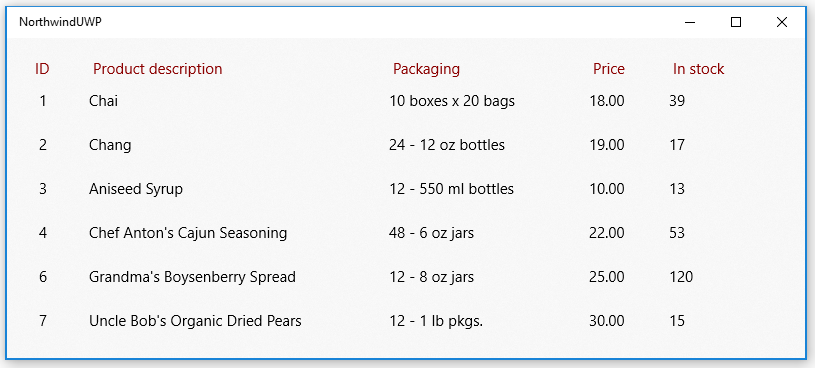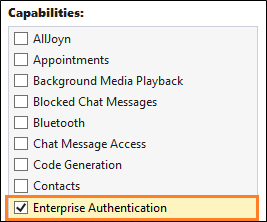UWP アプリでの SQL Server データベースの使用
アプリで System.Data.SqlClient 名前空間のクラスを使用して、SQL Server データベースに直接接続し、データを保存および取得することができます。
このガイドでは、それを行う方法の 1 つを示します。 Northwind サンプル データベースを SQL Server インスタンスにインストールし、ここで示すスニペットを使用して、Northwind サンプルのデータベースから取得した製品を表示する基本的な UI を作成します。

このガイドで示すスニペットは、このもっと完全なサンプルに基づいています。
まず、ソリューションをセットアップします。
アプリを SQL Server データベースに直接接続するために、プロジェクトの最小バージョンが Windows 10 Fall Creators Update (ビルド 16299) 以上を対象にしていることを確認します。 UWP プロジェクトのプロパティ ページにその情報があります。

マニフェスト デザイナーで、UWP プロジェクトの Package.appxmanifest ファイルを開きます。
Windows 認証を使用してご利用の SQL Server を認証する場合は、 [機能] タブで [エンタープライズ認証] チェックボックスを選択します。

重要
また、Windows 認証を使用しているかどうかにかかわらず、インターネット (クライアントとサーバー)、インターネット (クライアント)、およびプライベート ネットワーク (クライアントとサーバー) を選択する必要があります。
SQL Server データベースのデータの追加と取得
このセクションでは、以下のことを行います。
1️⃣ 接続文字列を追加します。
2️⃣ 製品データを保持するクラスを作成します。
3️⃣ SQL Server データベースから製品を取得します。
4️⃣ 基本的なユーザー インターフェイスを追加します。
5️⃣ UI に製品を追加します。
注意
このセクションでは、データ アクセス コードを編成する方法の 1 つを示します。 つまり、System.Data.SqlClient を使用して、SQL Server データベースのデータを保存および取得する方法の例を示すだけです。 アプリケーションの設計に最も適した方法でコードを編成してください。
接続文字列を追加する
App.xaml.cs ファイルで、App クラスにプロパティを追加します。これにより、ソリューションに含まれる他のクラスが接続文字列にアクセスできるようになります。
接続文字列は、SQL Server Express のインスタンスの Northwind データベースを指しています。 このスニペットの接続文字列は、SQL Server Express のインストール時に既定のインスタンス名SQLEXPRESSを保持していることを前提としています。 SQL Server インスタンス、データベース、および認証方法に合わせて、接続文字列に変更を加えることができます。
sealed partial class App : Application
{
// Create a connection string using Windows Authentication.
private string connectionString =
@"Data Source=.\SQLEXPRESS;Initial Catalog=NORTHWIND;Integrated Security=SSPI";
public string ConnectionString { get => connectionString; set => connectionString = value; }
...
}
重要
運用アプリケーションでは、接続情報をアプリ構成に安全に格納する必要があります (「Visual Studio 接続済みサービスを使用して Azure App Configuration を追加する」を参照してください)。 接続文字列やその他のシークレットは、ハードコーディングしないでください。
製品データを保持するクラスを作成する
XAML UI でこのクラスのプロパティに属性をバインドできるように、INotifyPropertyChanged イベントを実装するクラスを作成します。
public class Product : INotifyPropertyChanged
{
public int ProductID { get; set; }
public string ProductCode { get { return ProductID.ToString(); } }
public string ProductName { get; set; }
public string QuantityPerUnit { get; set; }
public decimal UnitPrice { get; set; }
public string UnitPriceString { get { return UnitPrice.ToString("######.00"); } }
public int UnitsInStock { get; set; }
public string UnitsInStockString { get { return UnitsInStock.ToString("#####0"); } }
public int CategoryId { get; set; }
public event PropertyChangedEventHandler PropertyChanged;
private void NotifyPropertyChanged(string propertyName)
{
PropertyChanged?.Invoke(this, new PropertyChangedEventArgs(propertyName));
}
}
SQL Server データベースから製品を取得します。
UWP プロジェクトの MainPage.xaml.cs ファイルで、Northwind サンプル データベースから製品を取得し、Product インスタンスの ObservableCollection コレクションとしてそれらを返すメソッドを作成します。
public ObservableCollection<Product> GetProducts(string connectionString)
{
const string GetProductsQuery = "select ProductID, ProductName, QuantityPerUnit," +
" UnitPrice, UnitsInStock, Products.CategoryID " +
" from Products inner join Categories on Products.CategoryID = Categories.CategoryID " +
" where Discontinued = 0";
var products = new ObservableCollection<Product>();
try
{
using (var conn = new SqlConnection(connectionString))
{
conn.Open();
if (conn.State == System.Data.ConnectionState.Open)
{
using (SqlCommand cmd = conn.CreateCommand())
{
cmd.CommandText = GetProductsQuery;
using (SqlDataReader reader = cmd.ExecuteReader())
{
while (reader.Read())
{
var product = new Product();
product.ProductID = reader.GetInt32(0);
product.ProductName = reader.GetString(1);
product.QuantityPerUnit = reader.GetString(2);
product.UnitPrice = reader.GetDecimal(3);
product.UnitsInStock = reader.GetInt16(4);
product.CategoryId = reader.GetInt32(5);
products.Add(product);
}
}
}
}
}
return products;
}
catch (Exception eSql)
{
Debug.WriteLine($"Exception: {eSql.Message}");
}
return null;
}
基本的なユーザー インターフェイスを追加する
次の XAML を、UWP プロジェクトの MainPage.xaml ファイルに追加します。
この XAML では、ListView を作成して前のスニペットで返された各製品を表示し、ListView 内の各行の属性を Product クラスで定義したプロパティにバインドします。
<Grid Background="{ThemeResource SystemControlAcrylicWindowBrush}">
<RelativePanel>
<ListView Name="InventoryList"
SelectionMode="Single"
ScrollViewer.VerticalScrollBarVisibility="Auto"
ScrollViewer.IsVerticalRailEnabled="True"
ScrollViewer.VerticalScrollMode="Enabled"
ScrollViewer.HorizontalScrollMode="Enabled"
ScrollViewer.HorizontalScrollBarVisibility="Auto"
ScrollViewer.IsHorizontalRailEnabled="True"
Margin="20">
<ListView.HeaderTemplate>
<DataTemplate>
<StackPanel Orientation="Horizontal" >
<TextBlock Text="ID" Margin="8,0" Width="50" Foreground="DarkRed" />
<TextBlock Text="Product description" Width="300" Foreground="DarkRed" />
<TextBlock Text="Packaging" Width="200" Foreground="DarkRed" />
<TextBlock Text="Price" Width="80" Foreground="DarkRed" />
<TextBlock Text="In stock" Width="80" Foreground="DarkRed" />
</StackPanel>
</DataTemplate>
</ListView.HeaderTemplate>
<ListView.ItemTemplate>
<DataTemplate x:DataType="local:Product">
<StackPanel Orientation="Horizontal" >
<TextBlock Name="ItemId"
Text="{x:Bind ProductCode}"
Width="50" />
<TextBlock Name="ItemName"
Text="{x:Bind ProductName}"
Width="300" />
<TextBlock Text="{x:Bind QuantityPerUnit}"
Width="200" />
<TextBlock Text="{x:Bind UnitPriceString}"
Width="80" />
<TextBlock Text="{x:Bind UnitsInStockString}"
Width="80" />
</StackPanel>
</DataTemplate>
</ListView.ItemTemplate>
</ListView>
</RelativePanel>
</Grid>
ListView で製品を表示する
MainPage.xaml.cs ファイルを開き、ListView の ItemSource プロパティを Product インスタンスの ObservableCollection に設定するコードを、MainPage クラスのコンストラクターに追加します。
public MainPage()
{
this.InitializeComponent();
InventoryList.ItemsSource = GetProducts((App.Current as App).ConnectionString);
}
プロジェクトを開始すると、Northwind サンプル データベースから取得した製品が UI に表示されます。

System.Data.SqlClient 名前空間を調べて、SQL Server データベース内のデータを使用して他に何ができるかを確認してください。
データベースへの接続で問題が発生した場合
ほとんどの場合、SQL Server 構成のいくつかの側面を変更する必要があります。 Windows フォームや WPF アプリケーションなどの別の種類のデスクトップ アプリケーションからデータベースに接続できる場合は、SQL Server の TCP/IP を有効にしていることを確認します。 これは、コンピューターの管理コンソールで行うことができます。 (詳細については、「Windows ツール/管理ツール」を参照してください。)

次に、SQL Server Browser サービスが実行されていることを確認します。

次のステップ
簡易データベースを使用して、ユーザー デバイスにデータを保存する
「UWP アプリでの SQLite データベースの使用」をご覧ください。
複数のプラットフォームにわたる異なるアプリの間でコードを共有する
デスクトップと UWP 間のコード共有に関するページをご覧ください。
Azure SQL バックエンドでマスター/詳細ページを追加する
顧客注文データベースのサンプルをご覧ください。